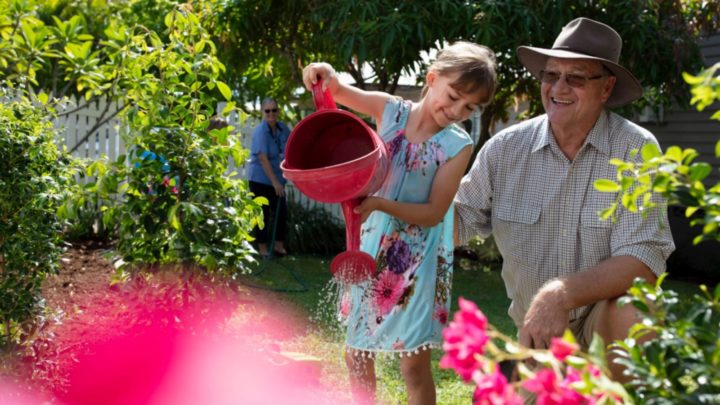
You’ve no doubt read about the valuable assistance available from the federal government to help your mum, dad or loved one continue to live independently in their own home – and that that assistance is in high demand.
So, the headlines sound promising, but what does it mean for your family? Penni Dring, an expert on aged care at iconic Queensland aged care provider Blue Care, has helped Starts at 60 lay out the key facts on home care, including what government funding covers and the best way to access that funding for your loved one.
There are two federal government subsidy schemes for home care services – the Commonwealth Home Support Programme (CHSP) and the Home Care Package (HCP) system – but it can be difficult to know what scheme is most relevant to your family member.
Your first stop is My Aged Care, the government’s website for all aged care-related information and services. If you’ve never used My Aged Care before, you can read up on what help is available here, before phoning 1800 200 422 between 8am-8pm Monday-Friday and 10am-2pm Saturday to register with the aged care system.
Registration requires a Medicare card number, so if you’re registering for a family member, make sure you have their number. After a short assessment of their situation over the telephone with a My Aged Care consultant, you’ll be directed to either the CHSP or the HCP avenue for funded home care.
Understanding the difference between the CHSP and an HCP
The CHSP provides the entry level of funding for aged care in the home, designed to deliver a basic level of care or shorter-term care to older Australians. The care services offered by the CHSP are often used by older people who’re recovering from an illness, injury or surgery and just need some help, for example, in shopping for groceries or cleaning the house over a shorter term.
Before that care can be provided, My Aged Care may send a Regional Assessment Service (RAS) assessor to your loved one’s home to get more detail on their needs. Once that assessment is complete, My Aged Care will then refer your loved one to an approved home care service provider of your choice and subsidise the required home care services up to the value of about $8,000 a year.
CHSP services aren’t means tested, which means your family member’s income or assets have no impact on the subsidy your approved home care provider receives from the government toward the cost of their home care services. The CHSP requires just a small contribution from the care user toward those costs and, once funding is approved by My Aged Care, will organise the services directly with a home care provider such as Blue Care.
If your phone assessment indicates a more complex array of care is required, an assessor from the Aged Care Assessment Team (ACAT) will visit your loved one’s home instead, to assess which one of four Home Care Package (HCP) service levels is best matched to their needs.
If they are assessed as eligible, your family member will be placed on a waiting list for a subsidised HCP. If their needs are particularly urgent, the assessor may recommend to My Aged Care that they receive assistance through the CHSP while they wait for HCP funding.
HCP funding is income-tested, so your family member will be required to undertake an income assessment with Centrelink, which will determine if the government will provide the full subsidy amount or reduce it for you to contribute the rest toward the cost of your services. (The family home isn’t included in this assessment.)
This contribution, if required, is called an Income-Tested Fee (ITF). It’s wise to discuss any financial obligations you may have with your chosen home care provider before you start using its services.
Blue Care’s expert Penni Dring advises anyone considering home care to use My Aged Care’s online income assessment tool, which asks just three questions to deliver an estimate of the fees a home care service provider is likely to charge on top of the government’s subsidy for the services your family member requires.
The four HCP ‘levels of need’ start at Level 1, which covers the most basic types of care, up to a rough value of $8,250 per year. Level 2 is for people with low-care needs ($15,000), Level 3 covers intermediate care needs ($33,000) and Level 4 is for high-level care needs ($50,250).
Dring says a Level 1 HCP suits someone who simply needs a bit of help with household chores, using the example of a person who has back pain that makes it difficult for them to hang out the laundry or vacuum the floors.
“Usually, they still drive, so they can still take themselves down to Woolies to get their groceries, for example,” she says of a typical Level 1 recipient. “But their bodies just can’t move as well as they used to.”
Level 2 HCP recipients are usually still able to live reasonably independently, but with some additional support.
“[Level 2 care] starts to move into things like social support,” Dring explains. “That could be grocery shopping, banking, clothes shopping; it could even be that we just take them down to the beach because they would like to go and see the water.”
She says the support Blue Care can provide covers a huge range of needs, from assistance with reading and writing letters to purchasing white goods or home safety or mobility aids and even taking care of beloved pets. This is because the types of home care available aren’t written in stone, but can develop through a conversation between the service provider and the person needing care.
“The government’s booklet on home care services certainly doesn’t say dog walking is included, but a lot of our clients do have little dogs that are their best friend in the world, that without them in the house for them to talk to and cuddle, it would just really be so distressing for them, so we have to try and keep that pet as healthy or alive for as long as possible,” Dring notes.
“Basically, the questions we consider are, if we don’t do this for this client, or if we don’t purchase this for this client, how is that going to affect their ability to stay in their own home? How is it going to affect their health, their wellbeing, moving forward?”
Level 3 and 4 packages are assigned to older Australians who have more complex care needs. This might include personal care tasks such as bathing and dressing, which they may not be comfortable with family members doing, to assistance with medication, nursing or allied health services.
“It could be that they’re still very well supported by their family, they still get their groceries done by the family, the family still cooks for them, but the things that the families can’t do, because they go to work or for dignity reasons, we can do,” Dring says.
The amount your family member will need to pay, if anything, towards their home care services depends entirely on their individual circumstances; their income and assets (other than the family home) and their care needs.
Full Age Pensioners, for example, would usually not be required to make any contribution toward home care services, while the maximum an Australian can be asked to contribute toward the cost of their own care is of $10,920.80 per year. The government covers the rest of the costs of care, up to the maximum amount allowed by each level of needs.
But there is an additional cost, called the basic daily fee (BDF), that home care providers are permitted to charge. This is set at 17.5 percent of the single, full Age Pension, so is revised twice a year in line with the pension – it currently sits at $10.43 and is charged for every day a person has an active HCP (not every day they actually receive services).
The BDF is collected by the home care service provider and added to the pool of money available for the client to spend on their services. If an HCP is stopped, the service provider will calculate any unspent contributions by the client and government and return them to who provided it.
“The government, no matter what financial situation the client is in, would like everybody to contribute to the cost of their Home Care Package,” Dring explains. “We discuss all government options with our clients to make their decisions easier. Any HCP client at any time can top up funds with their own money to receive the services they wish.”
She urges people who feel a family member would benefit from home care to contact My Aged Care. Blue Care also offers no-cost, obligation-free guidance and advice for families navigating the aged care system.
“We often suggest people meet with us so we can show them on paper, face to face, [how the system works] because that makes it a lot easier to understand,” she adds.

As one of Queensland’s leading in-home, retirement living and aged care providers Blue Care can deliver tailored support for you or your loved ones. With expert advice and over 65 years’ experience, Blue Care will make things simpler, so you and your family can continue to live life your way.